Nfpa 13 2002 Pdf Free Download
| If you've been following the blog for awhile, you might already know about the Toolkit that has really taken off lately. This past week I've incorporated some (great) user feedback and now have a new version to present: I've revamped the organization and it's FAR easier to navigate and use now. With a new main menu and crisp pages the Toolkit is FAR easier to navigate. Now you can get what you need, quickly. If you're already a subscriber to the Toolkit, use the download link below to get the latest version right now. No need for any new access codes - it just updates the Toolkit right over your current version. A clip of the latest version of the Sprinkler Obstruction Calculator on the MeyerFire Toolkit. What is the Toolkit, and what does it include? The MeyerFire Toolkit is a downloadable series of excel-based tools that allow fire protection designers, engineers and code authorities to quickly calculate a myriad of regular applications. With this tool you can save time with quick but powerful tools that you can save, PDF, or print. The Toolkit containsallof the tools you see on this website - plus the popular Fire Sprinkler Database - which is a live collection of all fire sprinklers on the market where you can sort and filter to see what products exist for your application, and then specify or design the ones that best match your design goals. What's Next? There's a few new additions to the Toolkit I hope to debut in the next couple weeks based on suggestions from users just like you. If you're an expert in fire flow calculations or water storage tank design and are interested in early testing, email me at jdmeyer@meyerfire.com. Subscribe If you know someone who might be interested in giving the Toolkit a try, email them about downloading it today. As always, you can subscribe to these weekly articles & resources here. Perhaps one of the most seemingly straightforward but actually complex topics of fire protection is the use of fire sprinklers to achieve passive fire resistance requirements. This week I'm diving into an introduction of different methods of using sprinklers for passive fire protection and discussing some of the design abuse therein. If you've encountered it, you're surely already familiar with how big of a topic it is. Three Methods for Protection of Windows Where windows are provided in fire-resistance rated components (a fire partition or barrier, as sprinklers are not permitted to be used for fire walls), the opening must be addressed in a manner that maintains the fire-resistance of the rated enclosure. The driver for these requirements is the building code. Option 1: Rated Glazing The first method to address openings in rated walls is provide a glazing assembly that is rated. The International Building Code qualifies two types or ratings- fire-resistance-rated or fire protection rating. The former is tested to ASTM E119 or UL 263 and is not considered an opening. The later (fire protection rating) is tested to NFPA 257 or UL 9 and has limitations on overall size. (IBC 2018 Fire-Rated Glazing Definition) Of the three options, this one is the most costly. Cited costs of fire rated glazing alone can be nearly $100 per square foot. For a large 10 foot x 6 foot window, for instance, that's over $6,000 for each panel. Option 2: Closely-Spaced Sprinklers (for Atrium Enclosures) Closely-spaced, standard sprinklers are used in glazing applications specifically for the protection of an atrium enclosure which contains glass. The closely-spaced sprinklers, used in conjunction with specific requirements for glass and frame, are only permitted in the International Building Code as an alternative to a 1-hour enclosure for atrium spaces. (IBC 2018 404.6) I'll discuss this in more detail, but the big takeaway here is that the building code only permits the use of closely spaced sprinklers as an alternative to a 1-hour enclosurefor atrium enclosures. Closely Spaced Sprinklers used in lieu of a 1-hour wall for atrium enclosures are the least-restrictive setup for sprinklers and glazing, with limited dimensional requirements and allowed use of multiple standard sprinkler types. Option 3: Window-Style Sprinklers The last method for treatment of windows in fire rated assemblies is to provide Tyco Window-Style sprinklers installed in accordance with their listing. The proper use of these sprinklers can achieve up to a 2-hour fire resistance rating with the use of glass. This method is not a prescribed code application but rather an "alternative method of construction" which requires documentation & support as an alternative, and must be approved by the AHJ. (IBC 2018 104.11) Fair warning - these sprinklers are roughly $400 each, and have major restrictions for their use (including specific sprinkler placement dimensions and glass requirements). Window-Style Sprinklers (by Tyco) can provide up to a 2-hour rating for a fire barrier. With wider application, these sprinklers also come with a significant list of limitations outlined in the product listing. Passive vs. Active Systems Passive fire protection requirements, such as the fire-resistance ratings of fire partitions, fire barriers, and fire walls, are required by code to limit the spread of fire. The term 'passive' is given as no intervention or dynamic activity is required in order for the system to function. Fire partitions, barriers and walls have a long history of successfully extending longevity of buildings in a fire, limiting spread, and increasing the ability of people to defend in place or escape a fire. Active systems are identified by a dynamic "action" that is required in order to function effectively. Automatic fire sprinkler systems are one type of active fire protection system, which require open valves, clear pathways, and in some cases the electrical and mechanical operation of fire pumps. Point-Counterpoint For & Against Fire Sprinklers for Passive Requirements This area of application isn't without controversy. There's opposite viewpoints on whether sprinklers should even be used as an alternative to passive fire protection. Here's a summary of the pros and cons: Use of sprinklers in conjunction with glass can afford many architectural opportunities without the expense of rated glazing, but restrictions are extensive, such as ensuring no combustibles are adjacent to the glass
The Common Misapplication I've often heard architects ask about using "water curtains" or "deluge sprinklers" when they have a rated fire barrier and are looking to incorporate a window. The request is commonly for "closely spaced" standard sprinklers to comprise a 1-hour or 2-hour fire barrier. I'm fairly confident that some part of me dies inside each time I hear either term - mostly because I know the education effort that always has to follow. The Basis for Closely Spaced Sprinklers The basis for standard, closely-spaced and located near glass, is provided in the International Building Code specifically for the enclosure of atria. An atrium is specifically an opening that connects two or more stories and is one method of interconnecting multi-level spaces and acknowledging vertical openings with fire safe goals in mind. Atrium spaces are unique in that they require fire sprinkler protection, a fire alarm system, and a smoke control system. All three of these components work in conjunction with each other to detect fire early in the process, notify occupants, and keep smoke to a manageable level while occupants escape. The International Building Code allows "closely spaced" sprinklers to be used with glass (with limitations) in lieu of a 1-hour enclosure specifically because of the other systems already provided for life safety. (IBC 2018 404.6) Misapplication for Non-Atrium Spaces While this section for atrium spaces has existing for some time, what has not existed in the building code has been the provision for closely spaced sprinklers to equate to 1-hour fire resistance rating. To put it simply, a documented basis for such an arrangement doesn't currently exist. Could it be proposed as a code alternative to a 1-hour fire barrier? Perhaps. But even without being an AHJ, I would question what technical evidence would support the use of closely-spaced sprinklers to be used in lieu of a 1-hour fire barrier. If I were an AHJ and closely-spaced sprinklers were proposed as a code alternative, I'd require a fire alarm system and a smoke control system for the space – just as is required for the atrium arrangement. Casual (Sloppy) Design Unfortunately, in some jurisdictions there's not enough resources and/or education for code officials and plan reviewers to monitor and police applications like this. Locally, I know of several jurisdictions who would immediately (and correctly) pounce on issues like this. I also know others where there is total reliance on the engineer for code compliance and proper design as there hardly is a plan review process. This sloppy design causes issues for everyone, especially for me when I have to be the bad guy and educate an architect or general contractor on future jobs. It's the common excuse of "that's what we did on the last job" that of course justifies continuing down the wrong design path. This is one reason I really enjoy working with knowledgeable and thorough AHJs as opposed to more "hands-off" jurisdictions. Free PDF Companion Download our free PDF comparison between these three applications, with major design implications outlined. Your Experience I' m very interested in what your experience has been with the use of sprinklers to meet passive window fire protection requirements. Help us by sharing your experiences on the topic in the comments section below. I look forward to the discussion. References & More Reading Arsenault, Peter. "Window Sprinklers as an Alternative to Fire-Rated Glass." Continuing Education Center, Tyco, continuingeducation.bnpmedia.com/courses/tyco/window-sprinklers-as-an-alternative-to-fire-rated-glass/3/. Kim, A.K., and G.D. Lougheed. "Fire Protection of Windows Using Sprinklers." Construction Technology Updates, 15 Mar. 2018, www.nrc-cnrc.gc.ca/ctu-sc/en/ctu_sc_n12/. Model WS-5.6 K-Factor Specific Application Window Sprinklers, Horizontal Sidewall and Pendant Vertical Sidewall. Tyco Fire Products Research & Development, 2016, Model WS-5.6 K-Factor Specific Application Window Sprinklers, Horizontal Sidewall and Pendant Vertical Sidewall, www.icc-es.org. Tyco Window Sprinkler, tyco-fire.com/index.php?P=detailprod&S=6200. I've heard that in order to publish on the internet all blog post titles must have a gripping click-bait title. This was my best attempt. Sorry to disappoint, but there is no love story here. Things are back on track this week - the last got a little busy at home last week when my wife and I welcomed our third child to the family. Even with the third, it's amazing how much joy and motivation kids can bring with their arrival. Needless to say I didn't have a whole lot of productivity last week, but I'm very glad you've tuned in. This week we're exploring requirements and challenges of sprinkler protection near overhead doors. Where Required Sprinklers are required under "fixed obstructions over 4 ft (1.2 m) in width." (NFPA 13 - 2002-16 8.5.5.3.1, 2019 9.5.5.3.1) One common application for this code section is overhead doors in the "open" position. Annex material even specifically references overhead doors as an applied example of this requirement. Sprinklers are required where the horizontal projection of an overhead door exceeds 4-feet. Application of the 4-ft Obstruction Rule If the overhead door doesn't create an obstruction over 4 feet (1.2 m) in width, then a sprinkler is not required to be provided beneath the door. This dimension is typically applied in the horizontal dimension only, and is measured as the horizontal projection of the edge of the door away from the wall. Depending on how creative things want to be architecturally, sprinklers can be avoided beneath overhead doors when the door assembly doesn't create a 4-foot horizontal obstruction. This can be the case with small coiling doors, door tracks that only run vertically up a wall, or a combination of vertical and horizontal tracks that don't project more than 4 feet out away from the wall. Hanger & Supporting Challenges NFPA 13 does not specifically address support for sidewall or upright sprinklers below an obstruction, but similar requirements can be extracted from criteria on pendent sprinklers served by branch pipe above a ceiling. If a sprinkler's horizontal steel branch pipe feed is greater than 1'-0" for systems with 100 psi or more, or greater than 2'-0" for any steel system, then a hanger is required to support the armover (NFPA 13 2002-16 9.2.3.4, 2019 17.4.3.4). This presents a natural challenge as the door track is typically only designed to support the forces of the door and isnotconsidered to be building structure capable of supporting the sprinklers, pipe and fittings. While it's very common for installers to attach the hanger to the door track, many see this as a violation of the hanging rules of NFPA 13. Supporting sprinklers beneath the overhead door can be a challenge due to the height differences between the door and the ceiling/roof structure above. Drainage & Dry Systems While this might not present a challenge with a single overhead door, multi-bay vehicle buildings could wind up having a low-point drum-drip for every or nearly every other overhead door. Aside from the cost, these drum drips are a maintenance nuisance as failure to drain these on a regular basis could result in a freeze and rupture of the drain assembly. Fortunately - in an update that I find very helpful - the latest edition of NFPA 13 now addresses where sprinklers can be located beneath obstructions. Sprinklers are required to be either located beneath the obstruction, or with their deflector no more than 3 inches off the side of the obstruction (see below). This was clarified in 2019 based on fire testing & research. New guidance for sprinkler protection beneath obstructions - new to the 2019 edition of NFPA 13. Your Challenges? What tips & tricks have you come across when dealing with sprinkler design around overhead doors? This site is created to start the discussion. Add your questions, tips & tricks in the section for your comments here. Subscribe Find this article interesting? Get more of my weekly articles & resources, for free, by subscribing here. This week we're covering a basic riser manifold configuration for wet-pipe fire sprinkler systems. This is not for a shotgun-style single riser, nor for a wet riser using an alarm check valve (we'll explore both of those later). If you haven't checked it out, there are great ongoing discussions (some of which covered these topics) on the MeyerFire Daily page here. Overview Check Valve
FDC Connection
What's not to like about a Top 10 list? If you know someone who may enjoy reading about this, please consider forwarding to a friend. Here's the top ten most popular articles and posts in this past year:
I hope you've had a great 2018 and are looking as forward to the coming year as I am. If you've found any of this helpful, consider sending this to a friend or encouraging them to sign up for these weekly articles here. Thanks in advance and have a great holiday and happy new year! If you work with sprinkler systems & review layouts, you've undoubtedly encountered sprinklers near ceiling fans. Today I'm taking a look at some of the requirements for sprinklers near fans, and the basis for those requirements. Traditional Ceiling FansThe chief concern with a typical residential-style ceiling fan is that the fan motor housing and fan blades could form an obstruction to proper sprinkler discharge. Motor Housing Obstruction NFPA 13 addresses the discharge from the motor housing by the Three Times Rule, where the sprinkler must be located three-times the width of the obstruction up to 24 inches (610 mm). Fan Blade Obstruction In terms of obstruction from the fan blades, NFPA 13 also allows sprinklers to be placed "without regard" to the blades of ceiling fans less than 60 inches (1.5 m) in diameter as long as the plan view is at least 50 percent open (NFPA 13 2010-19 under "Obstructions to Sprinkler Discharge Pattern Development" subsections in Chapter 8). NFPA 13R 3 and 5-foot Rules NFPA 13R takes a more straightforward requirement for positioning of sprinklers near ceiling fans - residential pendent sprinklers must be 3-feet and residential sidewalls must be 5-feet unless another sprinkler is positioned on the adjacent side, or, the sprinkler is positioned so that the fan is not considered an obstruction (NFPA 13R 2007 6.8.1.5.3, 2010-19 6.4.6). Residential style sprinklers are impacted by ceiling-mounted obstructions, such as lights and fans, to a greater degree than obstructions down from the ceiling since residential sprinklers throw with more high-wall wetting NFPA 13R Research Basis The NFPA 13R guidance was driven by fire modeling, sprinkler response tests, distribution tests, and full-scale fire tests by the National Fire Sprinkler Association and the Viking Corporation in 2005 (Valentine and Isman, Interaction of Residential Sprinklers, Ceiling Fans and Similar Obstructions). These tests indicated that the fan blades where not significant obstructions as long as the sprinkler was far enough away from the motor housing, allowing the sprinkler to control a fire on the other side of the fan in a small room. These tests also indicated that fans on low to medium speed did not significantly impact sprinkler performance, but high speed did. Despite the effect, the fire was still controlled in small rooms. Larger rooms, due to the size, would be expected to require additional sprinklers (NFPA 13R 2007 Annex). High Volume Low Speed Fans (HVLS) Fans moving larger volumes of air can have a significant impact on plume development and fire sprinkler response. In 2009, a research project sponsored by the Property Insurance Research Group (PIRG) and other industry groups, coordinated by the Fire Protection Research Foundation (FPRF) ran a series of 10 full-scale fire test and limited scale testing to evaluate the impact on sprinkler system performance. In 2011, a second phase was conducted by Factory Mutual Research Corporation. Recommendations from Research Based on the tests, effective sprinkler operation was obtained when the HVLS fans did not obstruct sprinkler discharge and were shut down upon the activation of the first sprinkler. The research also included shutdown by air-sampling type detection and use of ionization type smoke detectors, with earlier fan shutdown resulting in less commodity damage. FM Global's recommendations even extend into smoke detection devices or heat detection devices as an acceptable means to conduct the fan shutdown (provided uniformly above the fan blade area, per Data Sheet 548). Due to size and large air movement, High Volume Low Speed Fans (such as Big Ass fans) impact sprinkler discharge as both a potential obstruction and as a large air mover NPFA 13 Requirements for HVLS Fans NFPA 13 defines high volume low speed fans as ceiling fans approximately 6 feet (1.8 m) to 24 feet (7.3 m) in diameter, with a rotational speed of approximately 30 to 70 revolutions per minute (NFPA 13 2013-16 Section 3.3.14). Beginning with the 2013 Edition of NFPA 13, NFPA 13 has required four principal items concerning these large fans (NFPA 13 2013-16 Section 11.1.7 and 12.1.4 for storage): While NFPA 13 suggests centering the fan between four sprinklers - trying to convince an architect or mechanical engineer to shift their equipment based on the sprinkler system can be difficult to do. I've had better success designing the sprinkler locations around the fan location. Thoughts Since sprinklers are designed to be sensitive to air temperature and movement, ceiling fans can impact performance. With small ceiling fans, the biggest concern is obstructing sprinkler discharge, while for larger HVLS fans this chief concern moves towards the movement of air and impacting the response. Fortunately, research-backed recommendations have been provided to still allow effective fire sprinkler protection alongside ceiling fans. Subscribe Want more like this? Get these free weekly articles here. First, a huge thank you to everyone who's expressed interest and purchased the Toolkit - I very much appreciate the fantastic response to the launch over the last three weeks! It's a short post this week - I've been developing a Trapeze Hanger tool that sizes and schematically details trapeze hangers. This will likely be the first of three posts while developing this tool. Questions foryouat this point in time: (1) What other possible standard trapeze materials do you use that could be helpful as part of this tool? Click here to test and comment on the Trapeze Hanger tool, thanks in advance! Know someone who might be interested in resources or articles like this? Forward to a friend. Don't get these articles sent weekly to your inbox? Subscribe here. Based on some feedback and good ideas I've been experimenting with graphing fire pump & flow test curves with usable data outputs. Below is the first iteration for drawing a fire pump curve alongside a water supply curve. Determining ideal fire pump configurations for sprinkler and standpipe systems can be Here's the help I could really use from you - what else would be included in your ideal pump curve? Would you prefer this be on a logarithmic x-axis? Want 175 & 300 psi limit lines shown? Would you want to see at what height in a building the 175 psi threshold would occur - on this graph? System demand and hose? I'm open to any and all ideas - in the end I think it'd be great if this tool was the quickest & best method for summarizing and analyzing fire pump output. Share your ideas in the comments here, thanks in advance! This week's resource was a fun one to put together. Frequent Questions about NFPA 13 vs. 13R While those who ask are generally looking for ways to save on construction for the project, the differences are important and worth discussing early in a project. Designed for Different Purposes Unlike NFPA 13, NFPA 13R works to make the installation of the sprinkler system more affordable and accessible for residential occupancies by targeting the areas of highest fire risk to life safety with sprinkler systems. Swapping NFPA 13 and NFPA 13R is not simply a one-for-one exchange, as their goals are overall quite different. Summary of Differences As always, there's far more detail to many of these requirements than can be summarized in two pages - so be sure to use the supplied section references to gather more information on specifics for your project.
Download PDF Cheatsheet:
I've never trimmed a dry valve nor have I tested or drained a system myself. I'll also admit that for longer than I should have I never investigated the details of a dry valve. Hopefully with today's post if you've been in that same boat there's enough to better understand the basic components of a dry pipe valve. How Dry Pipe Valves Function Clapper Assembly It's purpose is to remain closed when air pressure is sufficient in the system, and open when the air pressure falls. The surface area of the clapper is disproportionately larger on the air side than the water side - which is intentional. To hold the clapper closed, the force on the clapper must be greater on the air side than the water side. Since force is pressure x area, a larger surface area on the air side means the air can be kept at a much lower pressure and still keep the clapper assembly closed - often to a ratio of 4:1 or 5:1 (allowing 40 psi of air to 120 psi of water pressure, for instance). External Reset The Knob incorporated in this dry valve is depressed to "unlatch" an open clapper, allowing it to reset back into its normal, closed position. It is a convenient function where a user doesn't have to open the face of the valve in order to reset it. Low Body Drain Valve Main Drain & Intermediate Chamber The main drain is used to drain water from the system, and is located below the clapper assembly. For dry valves, some models permit the main drain to be used to test the waterflow pressure switch without opening the clapper. In other models, there's an intermediate chamber between the water and air side which is normally dry. When water enters the intermediate chamber after the valve opens, the waterflow pressure switch senses water pressure and activates. In this configuration, there's usually a ball valve that can be used to test the waterflow pressure switch and fill the intermediate chamber without opening the dry valve. Pressure Gauges Pressure Switches The second pressure switch is included to activate when there is water in the intermediate chamber or is flooding the system. This is typically an alarm signal that also activates fire alarm notification in a building. Supply Shut-Off Valve Other Items In order to supply the air, or in many cases now nitrogen, an air compressor or nitrogen generator are provided to supply pressured air or nitrogen into the system. Summary Subscribe Today |
Posted by: reynaldareynaldaheanekeea0252255.blogspot.com
Source: https://www.meyerfire.com/blog/category/fire-suppression/7
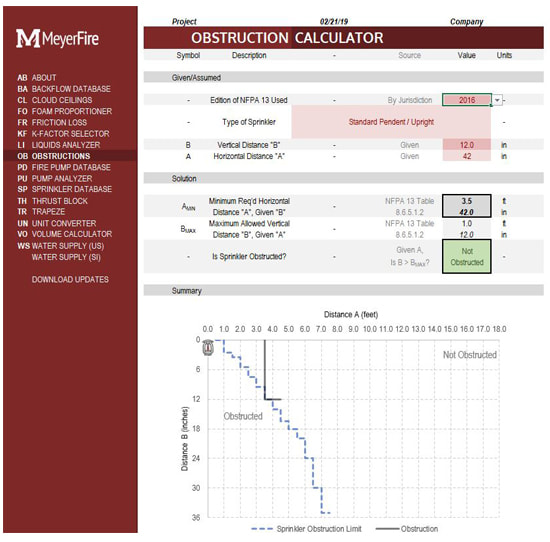
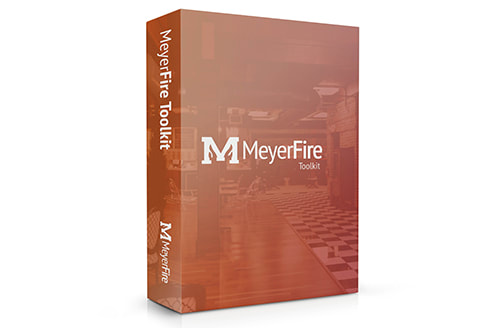
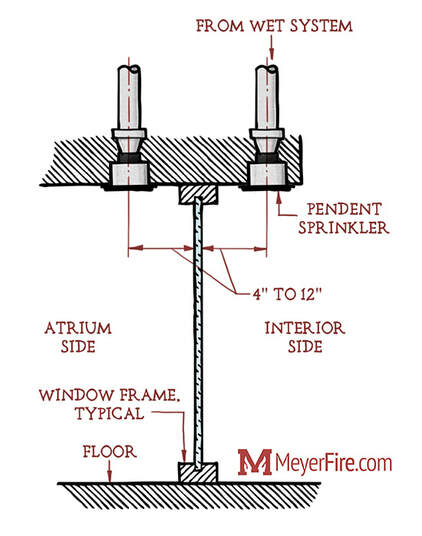
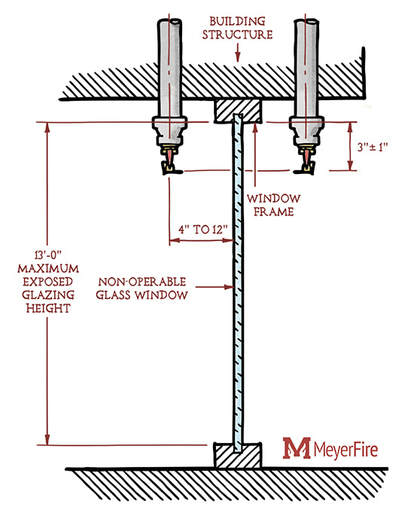
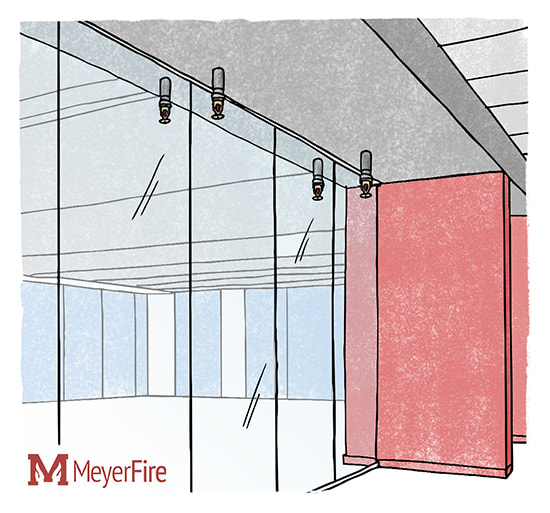
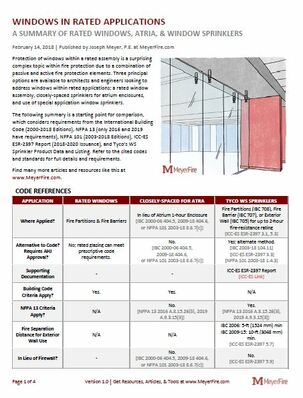
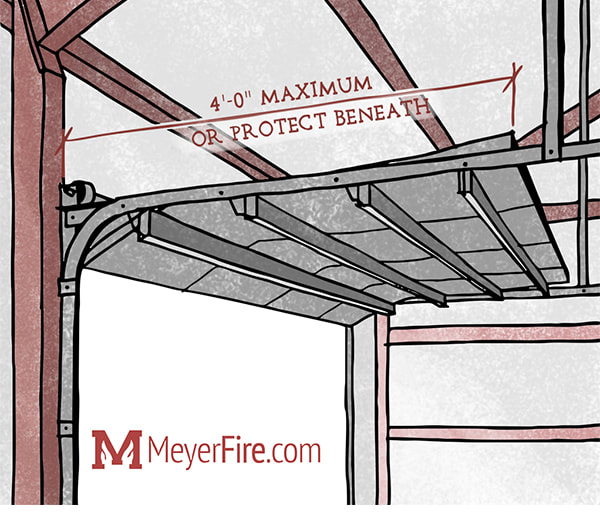
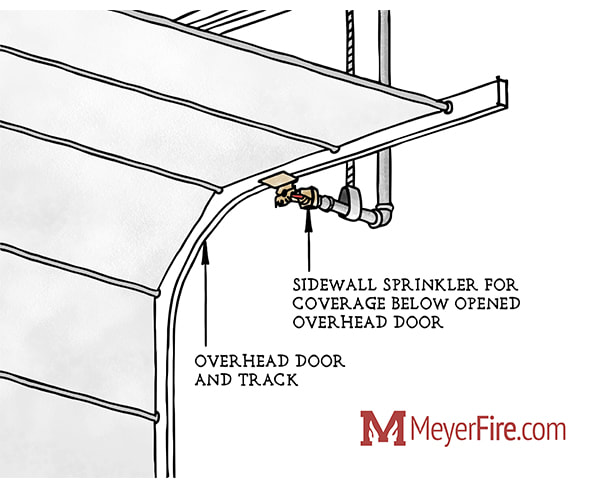
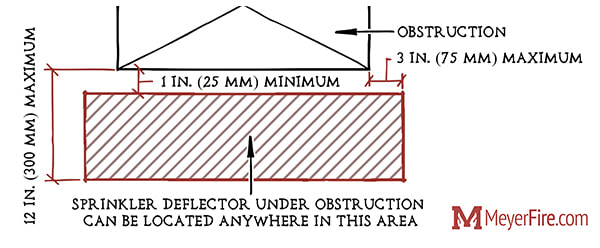
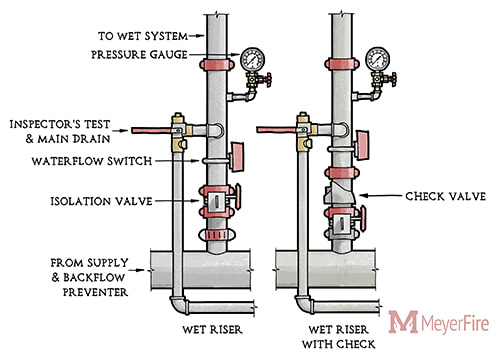
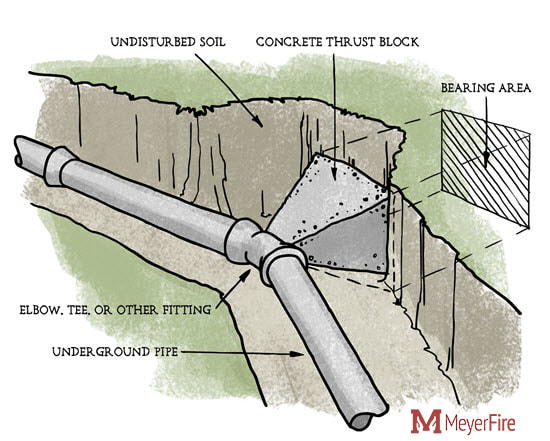
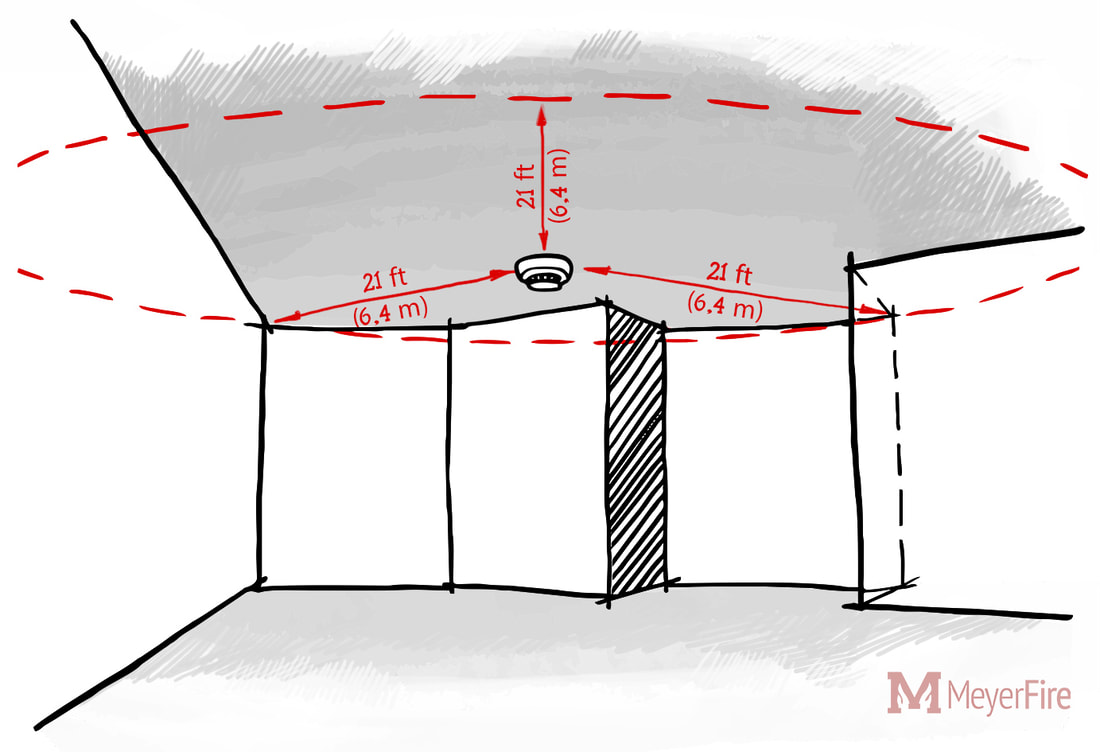
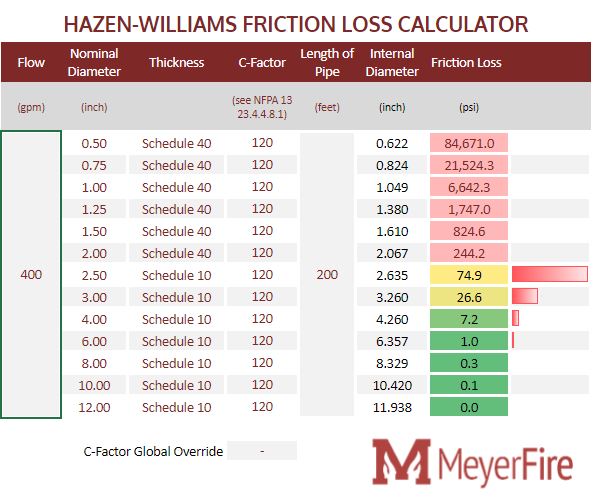
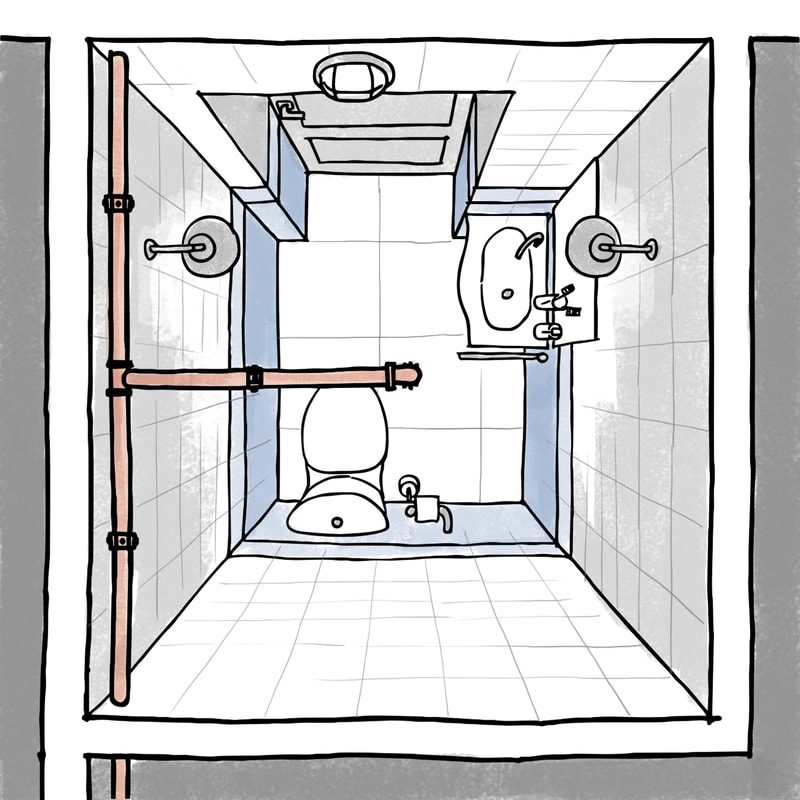
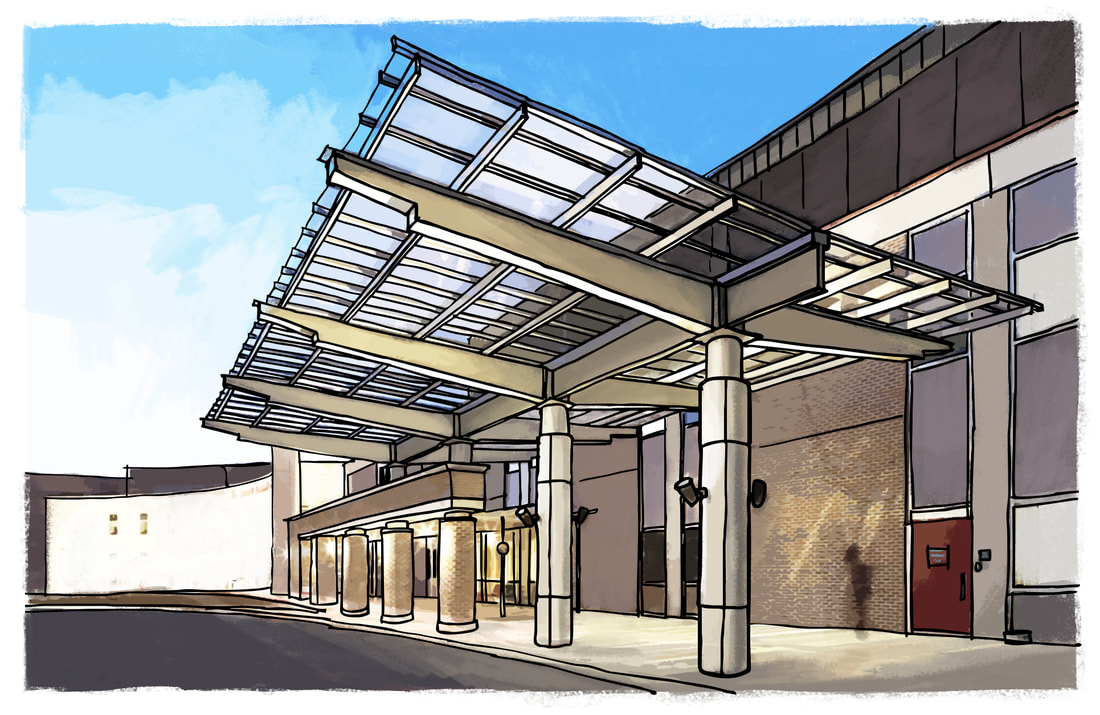
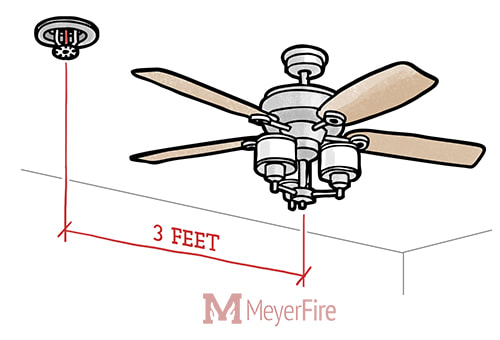
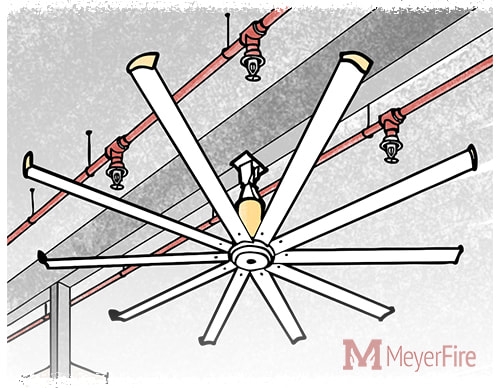
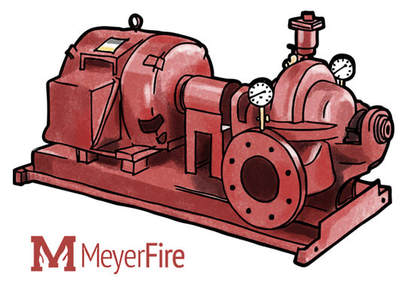
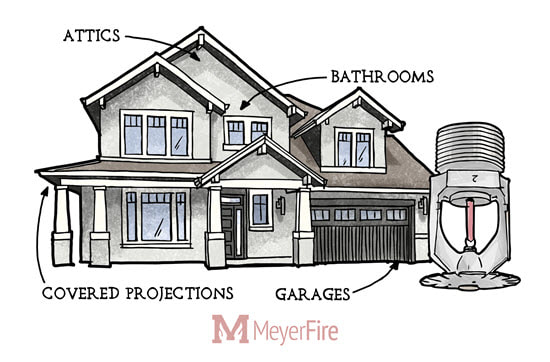
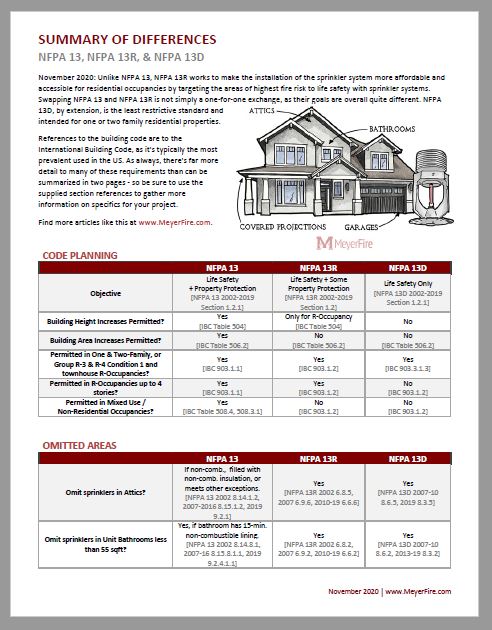
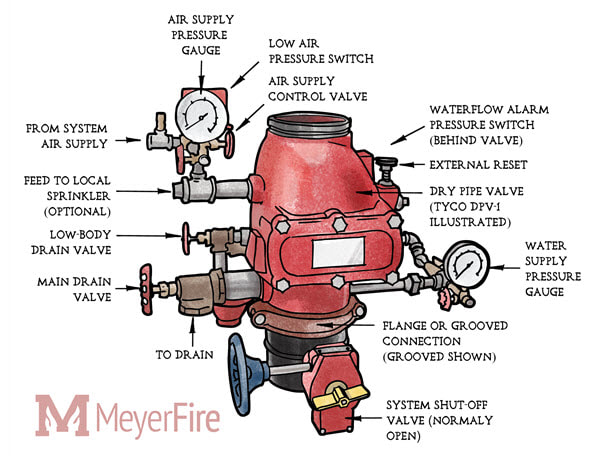

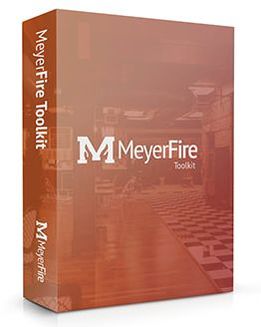

 RSS Feed
RSS Feed
Post a Comment for "Nfpa 13 2002 Pdf Free Download"